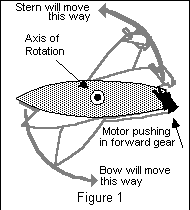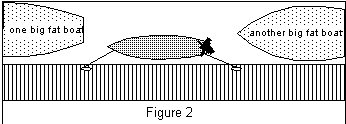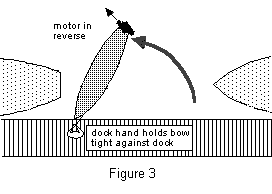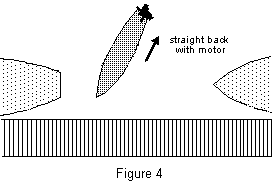![]()
Motors and Motoring
CSC Motor inventory
Presently, the club owns four motors that are designated as cruising motors: one 4 h.p. Suzuki, two Nissan 5 h.p., and one Nissan 8 h.p. The Nissans are most suitable for use on the Commanders, but the smaller Suzuki motor is adequate if you do not expect to have to deal with heavy currents, or do not expect to want to motor long distances in a hurry. The advantage of using any of the three smaller motors on the Commanders is that they are slightly lighter to lift, and permit somewhat greater maneuverability, because they rotate 360° on their shafts. Using larger motors than the 8 h.p. on the Commanders or the 5 h.p. on the Ensigns is not greatly advantageous, as the boats will approach a major percentage of hull speed with the power these motors provide. However, situations may arise, such as a four boat cruise, a catastrophic breakdown of all cruising motors, or a need to tow beached whales off the shoreline, when you would want to use one of the larger motors that are normally used for the dayleader skiff. It is o.k. to do this, but the club operating rules state that you must leave available one motor of 10 h.p. or greater, in good working condition, for use on the skiff. Be aware that these motors are much heavier than the regular cruise motors, and are a real gut-buster to lift on and off a transom.
Gas
All of our club motors use a 50:1 ratio gas/oil mix, except the Yamaha 30 h.p., which uses straight gas. ALL GAS TANKS AND CANS LABELED AS "RESERVED FOR THE YAMAHA" WILL CONTAIN UNMIXED GAS, SO THIS GAS SHOULD NEVER BE USED WITH ANY OF THE OTHER MOTORS. All other containers should never have anything in them but 50:1 gas/oil mix. Should you ever have occasion to buy gas, ALWAYS MIX OIL WITH THE GAS IN THE 50:1 CONTAINERS WHEN YOU REFILL THEM, BEFORE REPLACING THEM IN THE GAS LOCKER. The Port Captain, dayleaders, or delegated persons will usually buy and mix gas for use with the cruising and skiff motors, but the occasion might arise that you will find that the gas supply is running low. Of course, you will never want to leave insufficient gas for the dayleader to attend to his/her duties, so check the tank in the skiff and other containers in the locker, before taking gas for cruises. If you must buy gas, you might consider whether you have time and cash available to refill all empty containers and mix oil with them. If not, you will probably refill and use a 2.5 gallon external tank intended for the Nissans, though if you are going on a long cruise, you might want to use one of the 5 gallon tanks normally used with the skiff motors. If you are using a Suzuki, you will want to refill at least one of the 2.5 gallon jugs in order to refuel the internal 0.8 gallon tank while on your sail. You can be reimbursed for any gas that you buy for club use by filling out a voucher form available in the Treasurer's file in the clubhouse, and dropping it in the safe with receipts attached.
We use 87 octane regular gas in our motors. A supply of two stroke oil is maintained in the gas locker. The oil containers have instructions on them for measuring the amount of oil to add for each gallon, and a scale on the side to indicate the amount of oil being used. Be sure to measure carefully, as too lean a mix can damage the motors! Mix the oil with the gas thoroughly by shaking and swirling the container. It is helpful to label all containers with the date they were refilled and mixed.
When pouring gas between containers, always use a nozzle or funnel that contains a screen, to filter out dirt and other solid matter that might clog a carburetor or fuel filter.
The Suzuki integral gas tank holds 0.8 gallons of gas, which will last an hour at full throttle. The Nissans would use a bit more gas per hour.
When storing gas on the boat, close the vent on gas tanks until the motor is to be started and used. Make sure all caps are securely fastened on all other gas containers. Avoid storing gas in enclosed locations on the boat. On the Commander, note that the lazaret (stern compartment) is continuous to the area under the seats and thence into the cabin, so an open vent on a gas tank which spills over in wave action will generate fumes all the way forward into the cabin. Occasionally check the tank stored in the lazeret when sailing in heavy waves, as it sometimes overturns and spills. If the lazaret fills with water, bail it out, to assure that water does not seep into the tank.
Maintenance
There is a bulletin board inside the door of the motor locker which is intended to inform skippers of the condition of all club cruising motors. You can assist in keeping it updated by making entries yourself of any problems you have with motors, or erasing entries regarding problems which you have fixed.
Our operating rules state: "The outboard motor taken on a cruise shall be flushed in fresh water before being returned to the motor locker, whether it has been used or not."
If you should become involved in more adventurous maintenance, such as changing gear oil, spark plugs, or other mechanical parts, note what you have done in the Outboard Maintenance Records binder in the clubhouse.
If there is a problem with the motor that you cannot fix, label the motor before returning it to the motor locker, and notify the Motor Maintenance Chairman, Peter Kuhn.
If the motor should be accidentally immersed in salt water, the spark plug(s) should be removed and the motor should be cranked over with the pull-rope to evacuate the cylinder(s). As soon as possible, the motor should be flushed thoroughly with fresh water, including inside the cylinders. Afterward, 50:1 oil should be squirted through the spark plug ports, and the motor should be cranked over some more. Afterward, bring it to West Marine for servicing, if it is a Nissan, or to a Suzuki dealership, if it is a Suzuki.
Motor Installation
A safety line should always be used when transferring motors from the cart to the motor mount on the boat. There is usually a safety lanyard attached to the motor -- one convenient way of rigging a safety line is to tie the end of the main sheet to the end of the safety lanyard with a sheet bend.
Snug the mounting clamps down firmly, but not so tight that the wood of the motor mount is crushed or that the clamp handles are stressed to the point of breaking. Tie off the safety lanyard with a bowline knot to the hole at the base of a nearby cleat. Avoid installing a motor on a motor mount that is in a damaged condition -- use another boat, or fix the motor mount.
Be careful not to strain your back when lifting motors. Using levering techniques across your hip or thighs can reduce stress on your vertebrae.
In the case of two-boat cruises, note that it is possible to transport two motors at the same time on our converted golf cart contraption.
Operating
For details about operating motors, read the Nissan and Suzuki manuals in the Outboard Maintenance Records binder in the clubhouse.
If you inadvertently flood the motor while trying to start it, push the choke in all the way and open the throttle wide, and continue pull-starting.
When the Suzuki has been operated for an extended period of time until it is quite warm, then shut down, it sometimes will not restart easily. What usually seems to get them going is to fully choke it, to assist in clearing vapor lock. Push the choke in immediately after it starts.
With a full load of passengers in your boat, the motor, when lowered to its operating position, may sink to an extremely low level in the water. In heavy waves, it may then submerge occasionally. Have your passengers move their weight forward to keep the motor at an optimal level. In heavy chop, the motor may sometimes rise high enough out of the water for the propeller to expose. One of your crew should then be stationed at the motor to throttle it down whenever rpm's become excessive.
Note that there are adjustment screws, bolts, etc. on the motor shafts and throttle arms, for adjustment of tension. These are normally loosened when operating a skiff, but tightened when operating a keelboat, so that the motor can be left untended while used over long distances.
In order to reduce drag from the rudder when motoring over long distances, it is a good idea to fine tune the turning alignment of the motor so that it is not attempting to execute a continuous slight turn. This can be done by letting the tiller go slack and steering with the motor until a position is found where the boat will hold a relatively straight course.
If you have been operating the motor for some time, check your gas tank level before entering hazardous areas, such as shipping lanes, busy marinas, or near rocky shorelines, and refuel, if necessary.
When not operating the motor, the motor mount should be raised and the motor should be tilted, to reduce drag and to prevent the motor from immersing in the water when the stern dips in wave troughs. (Raising the motor also reduces exposure to salt water corrosion.) On the Suzukis, make sure that the gas vent is closed before tilting the motor.
Nissan recommends that its motors not be operated at over 80% throttle, except in emergencies, in order to prolong motor life and improve fuel economy. Maneuvering  Note that when you move the throttle arm of the motor to turn the boat, that the boat turns on an axis near its center, so that both the bow and stern swing through wide
roundhouse arcs. (See figure 1.) This is particularly noticeable when moving at low speed or accelerating from dead in the water, especially in acutely sharp turns. If you attempt to turn
away from an object near by your stern, such as a mooring dock at which you have just been tied up, the stern may bang into it. In order to leave from a dock, you are going to have to
somehow distance your stern from it before turning away to leave it. If there are no other boats tied up in front of you, it may be possible to simply push the boat off at stern and bow
and let it drift away before accelerating and turning, but if there are obstructions around you, the situation becomes more complicated. Consider the case shown in figure 2.
Note that when you move the throttle arm of the motor to turn the boat, that the boat turns on an axis near its center, so that both the bow and stern swing through wide
roundhouse arcs. (See figure 1.) This is particularly noticeable when moving at low speed or accelerating from dead in the water, especially in acutely sharp turns. If you attempt to turn
away from an object near by your stern, such as a mooring dock at which you have just been tied up, the stern may bang into it. In order to leave from a dock, you are going to have to
somehow distance your stern from it before turning away to leave it. If there are no other boats tied up in front of you, it may be possible to simply push the boat off at stern and bow
and let it drift away before accelerating and turning, but if there are obstructions around you, the situation becomes more complicated. Consider the case shown in figure 2.
 Here your boat must clear a couple of major obstacles at both bow and stern. The remaining figures show a method of handling this situation. In figure 3, the stern line
has been let go, while a dock hand holds the bow tight against the dock. The motor is operated in reverse, turned to pull the stern away from the dock. Until the boat is at 90° from
the dock, the turning action will create a pressure that holds the bow against it, making it easier for the dockhand to hold the bow stationary. Before the boat is at quite 90°, the
dock hand climbs aboard, and the motor is turned to pull the boat straight back, as in figure 4. The boat should be backed off until it is in a position where the bow can be swung around
to point in the intended direction of travel, without the stern also swinging around into obstacles.
Here your boat must clear a couple of major obstacles at both bow and stern. The remaining figures show a method of handling this situation. In figure 3, the stern line
has been let go, while a dock hand holds the bow tight against the dock. The motor is operated in reverse, turned to pull the stern away from the dock. Until the boat is at 90° from
the dock, the turning action will create a pressure that holds the bow against it, making it easier for the dockhand to hold the bow stationary. Before the boat is at quite 90°, the
dock hand climbs aboard, and the motor is turned to pull the boat straight back, as in figure 4. The boat should be backed off until it is in a position where the bow can be swung around
to point in the intended direction of travel, without the stern also swinging around into obstacles.


Charles Clausen 11/27/92
revised 10/30/93, 11/17/94





